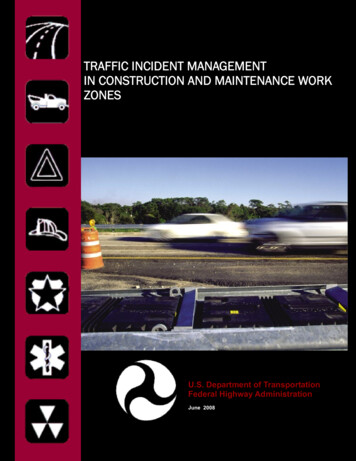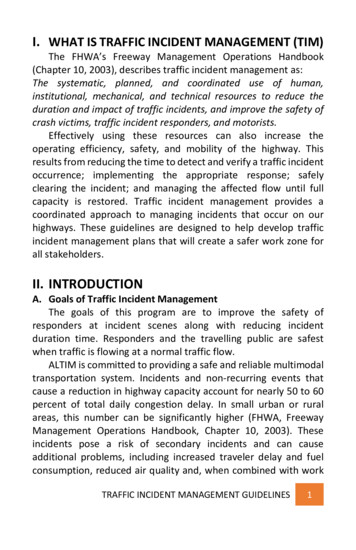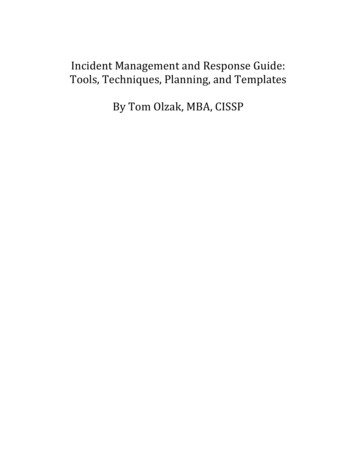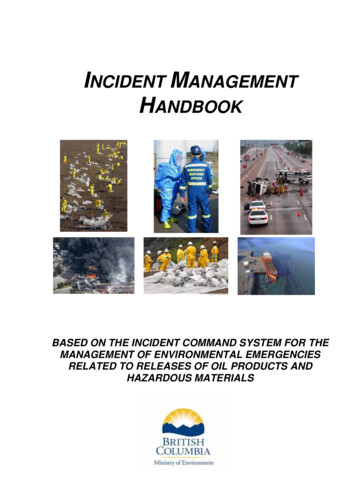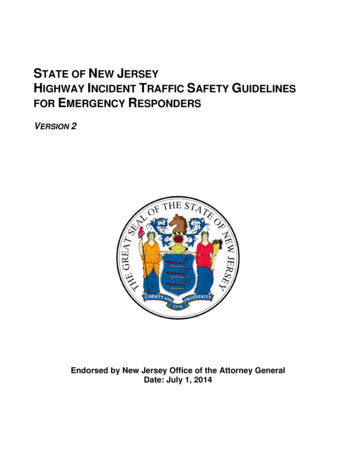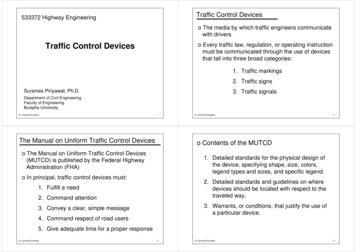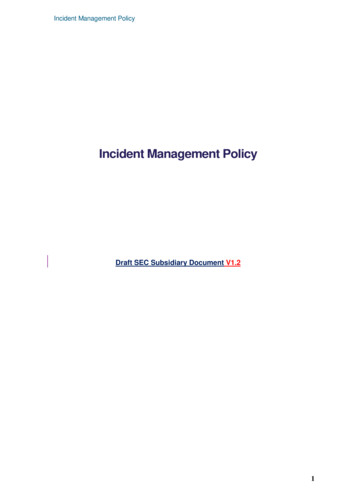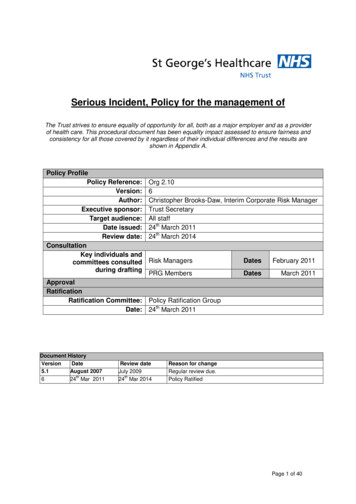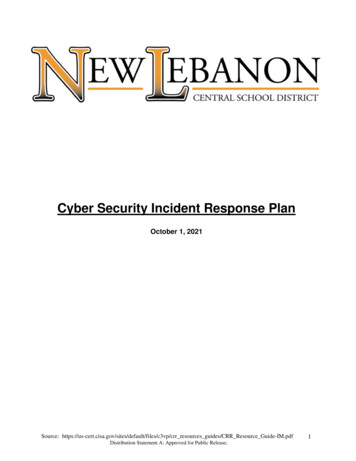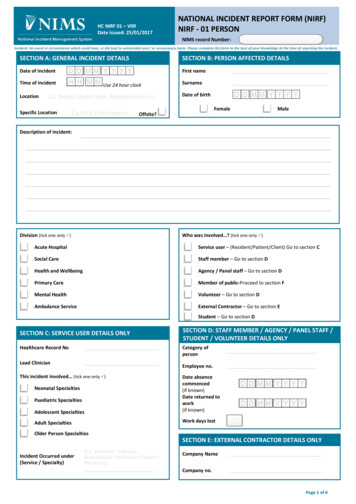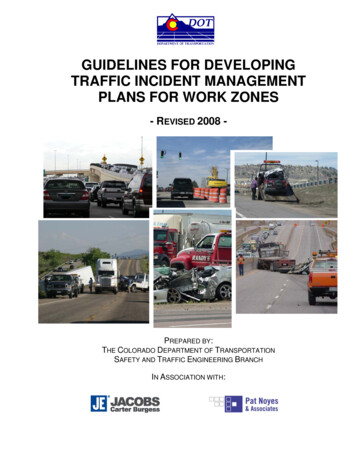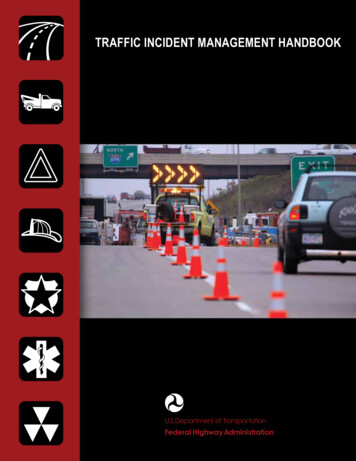
Transcription
TRAFFIC INCIDENT MANAGEMENT HANDBOOK
NOTICEThis document is disseminated under the sponsorship of the U.S. Department ofTransportation in the interest of information exchange. The U.S. Governmentassumes no liability for the use of the information contained in this document.This report does not constitute a standard, specification, or regulation.The U.S. Government does not endorse products or manufacturers. Trademarksor manufacturers’ names appear in this report only because they are consideredessential to the objective of the document.
QUALITY ASSURANCE STATEMENTThe Federal Highway Administration (FHWA) provides high-quality informationto serve Government, industry, and the public in a manner that promotes publicunderstanding. Standards and policies are used to ensure and maximize thequality, objectivity, utility, and integrity of its information. FHWA periodicallyreviews quality issues and adjusts its programs and processes to ensure continuousquality improvement.
2010 Traffic Incident Management Handbook UpdatePrepared for:Federal Highway Administration, Office of Transportation OperationsPrepared by:Science Applications International CorporationAmerican Transportation Research InstituteJanuary 2010
Technical Report Documentation Page1. Report No.2. Government Accession No.3. Recipient’s Catalog No.FHWA-HOP-10-0134. Title and Subtitle5. Report DateTraffic Incident Management HandbookJanuary 20107. Author(s)Nicholas Owens, SAIC, April Armstrong, SAIC, Paul Sullivan, SAIC, Carol Mitchell,SAIC, Diane Newton, SAIC, Rebecca Brewster, ATRI, Todd Trego, ATRI9. Performing Organization Name and Address6. Performing Organization CodeHOTO-18. Performing Organization Report No.10. Work Unit No. (TRAIS)Science Applications International Corporation (SAIC)8301 Greensboro DriveMcLean, VA 2210211. Contract or Grant No.DTFH61-06-D-000512. Sponsoring Agency Name and Address13. Type of Report and Period CoveredHandbookFederal Highway Administration, Office of OperationsU.S. Department of Transportation1200 New Jersey Avenue, SEWashington, DC 2059014. Sponsoring Agency CodeETO, HOTO-1, FHWA15. Supplementary NotesKimberly C. Vásconez, FHWA Office of Operations, Office of Transportation Operations, EmergencyTransportation Operations Team Leader and Contracting Officer’s Technical Monitor (COTM)16. AbstractThe 2010 version of the TIM Handbook includes the latest advances in TIM programs and practices across the countryand offers insights into the latest innovations in TIM tools and technologies. The 2010 TIM Handbook also features aparallel, web-based version that may be conveniently bookmarked, browsed, or keyword-searched for quick reference.This version supersedes the Freeway Incident Management Handbook (published by FHWA in 1991) and the TIMHandbook (published by FHWA in 2000). Readers will find the following topic areas in this Handbook: Introduction: This chapter provides an overview of Traffic Incident Management and sets the context for the 2010TIM Handbook update. TIM Strategic Program Elements: This chapter details the programmatic structure and institutional coordinationnecessary for a successful TIM program. TIM Tactical Program Elements: This chapter describes the full range of on-scene operations. TIM Support Program Elements: This chapter describes the communications and technical aspects of successfulTIM programs.A quick resource guide titled, “Want to Know More,” follows each chapter and direct readers to supplementalinformation associated with the specific chapter content.17. Key Words18. Distribution StatementEmergency Transportation Operations, Traffic IncidentManagement (TIM), Full-Function Safety/Service Patrols(FFSPs), Safe/Quick Clearance, Performance Measurements,Communications, TMCs, TOCs, Safety/Service Patrols,Freeway Operations, Traffic ControlNo restrictions19. Security Classif. (of this report)20. Security Classif. (of this page)21. No. of PagesUnclassifiedUnclassified11622. Price
Table of ContentsJanuary 2010Table of Contents1Introduction to Traffic Incident Management. 11.1Introduction. 11.2What’s at Stake. 11.3Traffic Incident Management: A Timeline for Progress. 31.3.1National Incident Management Coalition . 31.3.2National Highway Institute Training . 31.3.3National Conference on Traffic Incident Management . 31.3.4National Traffic Incident Management Coalition . . 41.3.5Traffic Incident Management Self-Assessment . 61.3.6Traffic Incident Management Performance Measures Focus States Initiative . 71.4Traffic Incident Management Redefined. 71.5Traffic Incident Management Stakeholders. 91.6A Handbook for Today’s Traffic Incident Management. 91.7What to Expect.101.8Want to Know More?.102TIM Strategic Program Elements. 132.1Introduction. 132.2Formalized TIM Programs. 132.32.42.52.2.1Evolution through NIMS. 132.2.2State Strategic Highway Safety Plans . . 142.2.3NTIMC TIM Program Guidance . 152.2.4Starting Small . .19Multi-Agency TIM Teams/Task Forces. 202.3.1Team Membership. 212.3.2TIM Team/Task Force Activities . 22TIM Performance Measurement . . 232.4.1TIM PM FSI – Measures to Track. 232.4.2TIM Performance Measures Focus States Initiative - Results of State Action Plans. 27Additional Resources. 302010 Traffic Incident Management Handbook Updateiii
Table of Contents3TIM Strategic Program Elements. 333.1Introduction. 333.2Response and Clearance Policies and Procedures. 343.33.2.1Responder Roles and Responsibilities. 343.2.2Incident Command System/Unified Command. 363.2.3Resource Typing and Identification. 433.2.4Fatal Incidents. 443.2.5Safe, Quick Clearance Laws and Policies. 453.2.6Full Function Service Patrols for Incident Response. 53Responder and Motorist Safety. 573.3.1Move Over Laws. 583.3.2Protective Apparel. 593.3.3Traffic Management/Vehicle Placement/Emergency Lighting. 613.4Additional Resources. 704TIM Program Support – Communications and Information Exchange. 734.1Introduction. 734.2Background.744.3Support to TIM Communications and Information Exchange. 774.3.1Operational Support . 774.3.2Technical Support. 794.3.3Institutional Support for Communications and Information Exchange. 844.4Challenges and Solutions to Real-Time Communications and Information Exchange. 854.5Supporting Policy and Guidance. 884.6ivJanuary 20104.5.1National Policy. 884.5.2National Association Support and Policy. 904.5.3State and Local Policies. 92Want to Know More?. 932010 Traffic Incident Management Handbook Update
List of FiguresJanuary 2010List of FiguresFigure 1.The Four “Es” of Highway Safety.15Figure 2.High-Level Process Overview of Focus States Initiative forTIM Performance Measures.24Figure 3.Incident Command Structure.38Figure 4.Unified Command Organization Structure.41Figure 5.Georgia DOT HEROS Unit.56Figure 6.ANSI/ISEA Standard 107-Compliant Vests.60Figure 7.MUTCD Traffic Incident Management Area.64Figure 8.Safe Positioning Diagram.67Figure 9.MUTCD-Compliant TIMA.68Figure 10.Information Flows in Emergency Response.752010 Traffic Incident Management Handbook Updatev
List of TablesJanuary 2010List of TablesviTable 1.NTIMC NUG Strategies.5Table 2.Traffic Incident Management Self-Assessment Sample Questions.6Table 3.TIM Stakeholders Roles and Descriptions.9Table 4.TIM-NIMS Crosswalk.14Table 5.TIM Program Key Elements.16Table 6.Summary of State Best Practices.17Table 7.Evolution of Statewide TIM Plan in Tennessee. 19Table 8.NTIMC Membership by TIM Stakeholder Group.21Table 9.Candidate Program-Level TIM Objectives and Performance Measures.25Table 10.TIM PM FSI Program-Level Performance Measures.27Table 11.TIM PM FSI Implementation Summary.28Table 12.TIM Stakeholder Roles and Descriptions.34Table 13.TIM Stakeholder Organizations Promoting SQC Nationwide.512010 Traffic Incident Management Handbook Update
List of AbbreviationsJanuary 2010List of AbbreviationsAAAAmerican Automobile AssociationAACNAdvanced Automatic Crash NotificationAASHTOAmerican Association of State Highway Transportation OfficialsACNAutomatic Crash NotificationANSIAmerican National Standards InstituteAPCOAssociation of Public-Safety Communications Officials – InternationalARTIMISAdvanced Regional Traffic Interactive Management and Information SystemATAAmerican Trucking AssociationsATAFAmerican Trucking Associations FoundationATISAutomated Traveler Information SystemsATSSAAmerican Traffic Safety Services AssociationAVLAutomatic Vehicle LocationCADComputer-Aided DispatchCaltransCalifornia Department of TransportationCapWINCapital Area Wireless Integrated NetworkCCDCharge-Coupled DeviceCCTVClosed-Circuit TelevisionCDOTColorado Department of TransportationCFRCode of Federal RegulationsCHARTCoordinated Highways Action Response TeamCHPCalifornia Highway PatrolCIRCritical Incident ReviewCO2Carbon DioxideCVVFACumberland Valley Volunteer Fireman’s AssociationDHSU.S. Department of Homeland SecurityDMSDynamic Message SignDOJU.S. Department of JusticeDOTDepartment of TransportationDVRPCDelaware Valley Regional Planning CommissionE911Emergency 911EMSEmergency Medical ServicesEPAU.S. Environmental Protection AgencyERSIEmergency Response Safety InstituteERUEmergency Response UnitESFEmergency Support FunctionETAEmergency Traffic AccommodationETOEmergency Transportation Operations2010 Traffic Incident Management Handbook Updatevii
List of AbbreviationsJanuary 2010FCCFederal Communications CommissionFDOTFlorida Department of TransportationFFSPFull Function Service PatrolFHPFlorida Highway PatrolFHWAFederal Highway AdministrationFITMFreeway Incident Traffic ManagementGPSGlobal Positioning SystemHARHighway Advisory RadioHazmat or HM Hazardous MaterialsviiiHEROSHighway Emergency Response OperatorsIACPInternational Association of Chiefs of PoliceIAFCInternational Association of Fire ChiefsIAFFInternational Association of Fire FightersIAPIncident Action PlanICIncident Command (function)ICSIncident Command SystemIEEEInstitute of Electrical and Electronics EngineersIENInformation Exchange Network ClearinghouseIFSTAInternational Fire Service Training AssociationIIMSIntegrated Incident Management SystemIJISIntegrated Justice Information SystemsIMIncident ManagementIMTFIncident Management Task ForcesINDOTIndiana Department of TransportationIRIncident ResponseISEAInternational Safety Equipment AssociationITEInstitute of Transportation EngineersITSIntelligent Transportation SystemsITS/PSIntelligent Transportation Systems and Public SafetyiVEDDSInteragency Video Event Data Distribution SystemJOPSJoint Operations Policy StatementLESSLaw Enforcement Stops & Safety SubcommitteeLLISLessons Learned Information SharingMOUMemoranda or Memorandum of Understandingmphmiles per hourMUTCDManual of Uniform Traffic Control DevicesNASEMSONational Association of State EMS OfficialsNCHRPNational Cooperative Highway Research ProgramNENANational Emergency Number AssociationNFPANational Fire Protection Association2010 Traffic Incident Management Handbook Update
List of AbbreviationsJanuary 2010NGNext-GenerationNGANational Governors AssociationNHINational Highway InstituteNIEMNational Information Exchange ModelNIFGNational Interoperability Frequency GuideNIFOGNational Interoperability Field Operations GuideNIMCNational Incident Management CoalitionNIMSNational Incident Management SystemNIOSHNational Institute for Occupational Safety and HealthNJDOTNew Jersey Department of TransportationNJSPNew Jersey State PoliceNRTNational Response TeamNTIMCNational Traffic Incident Management CoalitionNUGNational Unified GoalNVFCNational Volunteer Fire CouncilNYDOTNew York Department of TransportationOSCOn-Scene CoordinatorPDAPersonal Digital AssistantPennDOTPennsylvania Department of TransportationPIOPublic Information OfficerPMPerformance Measures or Performance MeasurementPOCPoint of ContactPSAPPublic Safety Answering PointPSPPennsylvania State PoliceQCQuick ClearanceRITAResearch and Innovative Technology AdministrationSAESociety of Automotive Engineers (International)SAFETEA-LUSafe, Accountable, Flexible, Efficient Transportation Equity Act: A Legacy for UsersSHRP IIStrategic Highway Research Plan IISHSPStrategic Highway Safety PlanSMESubject Matter ExpertSOSafety OfficerSOCState Operations CenterSOPStandard Operating ProcedureSOSINKSoutheast Indiana and Northern KentuckySQCSafe, Quick ClearanceSWOTStrengths, Weaknesses, Opportunities, and ThreatsTDOTTennessee Department of Transportationthe Handbook TIM HandbookTIMTraffic Incident Management2010 Traffic Incident Management Handbook Updateix
List of AbbreviationsxJanuary 2010TIMATraffic Incident Management AreaTIMETraffic Incident Management EnhancementTIM PM FSITIM Performance Measures Focus States InitiativeTIMSATraffic Incident Management Self-AssessmentTMCTransportation Management CenterTMTTransportation Management TeamTOCTraffic Operations CenterTRAATowing and Recovery Association of AmericaTTCTemporary Traffic ControlTTITexas Transportation InstituteUASIUrban Area Security InitiativeUCUnified CommandUDOTUtah Department of TransportationUMTRIUniversity of Michigan Transportation Research InstituteU.S.United StatesUSDOTU.S. Department of TransportationUSFAU.S. Fire AdministrationVMSVariable Message SignWFCWashington Fire ChiefsWisDOTWisconsin Department of TransportationWSAFCWashington State Association of Fire ChiefsWSDOTWashington State Department of TransportationWSPWisconsin State Patrol or Washington State Patrol2010 Traffic Incident Management Handbook Update
Introduction to Traffic Incident Management1January 2010Introduction to Traffic Incident Management1.1 IntroductionFor more than 20 years, transportation, public safety and private sector professionals haveworked cooperatively in traffic incident management (TIM) programs to safely and efficientlyclear traffic incidents and incident-related debris. As TIM programs have matured, programmanagers and field-level practitioners alike have benefited from Federal Highway Administration(FHWA) efforts to collect, document, and distribute good practices, lessons learned, and thenecessary steps for implementing, improving, and expanding TIM program components.The 2010 version of the Traffic Incident Management Handbook (the Handbook or TIMHandbook) includes the latest advances in TIM programs and practices across the country, andoffers practitioners insights into the latest innovations in TIM tools and technologies. The 2010TIM Handbook also features a parallel Web-based version that can be conveniently bookmarked,browsed, or keyword-searched for quick reference. This version supersedes the Freeway IncidentManagement Handbook published by FHWA in 1991 and the Traffic Incident ManagementHandbook published in 2000.The Handbook is organized according to the following chapter topic areas: Chapter 1: Introduction: This chapter provides an overview of Traffic IncidentManagement and sets the context for the 2010 TIM Handbook update. Chapter 2: TIM Strategic Program Elements: This chapter details the programmaticstructure and institutional coordination necessary for a successful TIM program. Chapter 3: TIM Tactical Program Elements: This chapter describes the full range of onscene operations. Chapter 4: TIM Program Support – Communications and Information Exchange: Thischapter describes the communications and technical aspects of successful TIMprograms.A quick resource guide titled, “Want to Know More?”, follows each chapter and directs readers tosupplemental information associated with the specific chapter content.1.2 What’s at StakeIn 2006, the U.S. Department of Transportation (USDOT) announced the “National Strategy toReduce Congestion on America’s Transportation Network”. In this strategy-defining document,USDOT defined congestion as “one of the single largest threats” to the Nation’s economicprosperity and way of life. The USDOT’s Fiscal Year 2006 to 2011 Strategic Plan1 identifiedreducing congestion as one of the Department’s key strategic goals.Department of Transportation: Strategic Plan Fiscal Years 2006-2011, available overview.12010 Traffic Incident Management Handbook Update1
Introduction to Traffic Incident ManagementJanuary 2010The impact of congestion on the Nation’s highways is well documented. In the 2009 UrbanMobility Report published by the Texas Transportation Institute (TTI), data calculated in 2007reported that based on wasted time—4.2 billion hours—and fuel—2.8 billion wasted gallons,congestion cost about 87.2 billion combined in the top 439 urban areas in the United States.2Traffic incidents have been identified as a major contributor to increased congestion. TheNational Traffic Incident Management Coalition (NTIMC) estimates that traffic incidents arethe cause of about one-quarter of the congestion on US roadways, and that for every minute afreeway lane is blocked due to a incident, this results in 4 minutes of travel delay time.3Improving traffic incident management is one key to reducing congestion. In the 2009 UrbanMobility study, TTI calculated that in 2007, where improved incident management procedureswere implemented in 272 of the 439 urban areas, the resulting reduction in incident-relatedcongestion saved 143.3 million hours and 3.06 million.4Improved TIM has been shown to reduce both overall incident duration as well as secondarycrashes. In the annual evaluation of its Coordinated Highways Action Response Team (CHART)program, the State of Maryland estimated that the CHART-directed incident managementresulted in average incident duration of 22 minutes, as compared to 29 minutes for otheragencies, and that this reduction in incident duration resulted in 290 fewer secondary incidents in2005.5 The impact of this reduction incident duration is demonstrated by a study published in theITS Journal that estimated that the likelihood of a secondary crash increases by 2.8 percent forevery minute that the primary incident remains a hazard.6In addition to the economic and safety impacts, congestion levies a very real human toll.According to the NTIMC, traffic crashes and struck-by incidents are leading causes of on-dutyinjuries and deaths for law enforcement, firefighters, and towing and recovery personnel.7 Asa result, increased responder safety is one of the three core objectives of the NTIMC’s NationalUnified Goal (NUG) for traffic incident management.An additional significant benefit of improved TIM and reduced congestion that is not oftenconsidered is the environmental benefit realized by reducing wasted fuel consumption. The U.S.Environmental Protection Agency (EPA) estimates that every gallon of gasoline burned emits 19.4pounds of carbon dioxide (CO2). For diesel fuel, the average is 22.2 pounds of CO2 per gallon ofdiesel fuel.8 Given that approximately 2.8 .billion gallons of fuel were wasted due to congestionin 2007, the environmental impact of reducing congestion and improving TIM is significant. Forexample, in Maryland, the reduction in incident duration for the CHART program of 7 minuteswhen compared to other agencies would result in a reduction of 135.8 pounds of CO2 for gasolineand 155.4 pounds of CO2 for diesel. Given that CHART reported 20,515 incidents that involved theblockage of one or more freeway lanes in 2005, the per-incident savings multiplied by the numberof incidents in Maryland alone demonstrates the potential impact in emissions reduction fromimproved traffic incident management.2TTI: 2009 Urban Mobility Report, July 2009, p. 14, available online: http://tti.tamu.edu/documents/mobility report 2009.pdf.3NTIMC: Benefits of Traffic Incident Management, available online: efits11-07-06.pdf.4TTI: 2009 Urban Mobility Report, July 2009, p. 14.Chang, Rochon: Performance Evaluation and Benefit Analysis for CHART—Coordinated Highways Action Response Team—in Year 2005 Final Report,University of Maryland, College Park, MD, May 2006.56Karlaftis, Latoski and Sinha Richards. “ITS Impacts on Safety and Traffic Management: An Investigation of Secondary Crash Causes,” ITS Journal,1999, Vol. 5, pp.39-52.7“Responder Safety,” National Traffic Incident Management Coalition, November 2006.EPA: Overview: Pollutants and Programs, “Emission Facts: Average Carbon Dioxide Emissions Resulting from Gasoline and Diesel Fuel,” availableonline: 0 Traffic Incident Management Handbook Update
Introduction to Traffic Incident ManagementJanuary 20101.3 Traffic Incident Management: A Timeline for ProgressTIM program progress has evolved over two decades and has benefited from a series of nationalinitiatives described in sections 1.3.1 through 1.3.6.1.3.1 National Incident Management CoalitionAs one of the earliest formal TIM initiatives, the National Incident Management Coalition’s(NIMC) work has been the genesis for a number of TIM programs across the country. In 1990, theAmerican Trucking Associations Foundation (ATAF) and its Trucking Research Institute publishedIncident Management,9 which was among the first documents to propose a link betweenthe effective management of traffic incidents and the country’s economic competitiveness.Concurrent with the publication of Incident Management, the ATAF collaborated with FHWAto create and manage the NIMC, an ad hoc coalition of national organizations dedicated toadvancing the cause of coordinated management of traffic incidents as a discipline.The NIMC’s work focused on outreach and education, introducing the concept of coordinatedincident response. Through a series of 20 outreach conferences held around the country from1991 to 1994, the NIMC brought together the diverse range of TIM stakeholders to make the caseand build consensus for multi-agency cooperation and coordination involved in clearing trafficincidents. In 1996 and 2001, the NIMC convened TIM expert focus groups to document currentTIM state-of-the-practice and future recommendations.1.3.2 National Highway Institute TrainingInitiated in 1998 and ongoing currently, the National Highway Institute’s (NHI) Managing TrafficIncidents and Roadway Emergencies training course is among the longest running TIM-relatedtraining courses ever offered. Designed for mid- to upper-level managers from TIM responderagencies, the curriculum focuses on institutional and technical aspects of multi-agency incidentclearance.10 Since its initial offering, the course has been taught more than 90 times, reachingsome 2,800 TIM practitioners.1.3.3 National Conference on Traffic Incident ManagementIn 2002, several key NIMC organizations convened the National Conference on Traffic IncidentManagement with goals to develop and promote an agenda for improved TIM at the nationallevel. More than 150 TIM stakeholders
CHART Coordinated Highways Action Response Team CHP California Highway Patrol CIR Critical Incident Review CO 2 Carbon Dioxide CVVFA Cumberland Valley Volunteer Fireman's Association DHS U.S. Department of Homeland Security DMS Dynamic Message Sign DOJ U.S. Department of Justice DOT Department of Transportation DVRPC Delaware Valley Regional .
